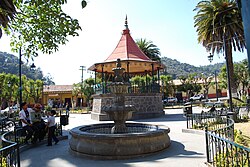Tlalpujahua (de Rayón) | |
|---|---|
Town and Municipality | |
 Kiosk in the center of Tlalpujahua | |
| Coordinates: 19°48′18″N 100°10′28″W / 19.80500°N 100.17444°W | |
| Country | |
| State | Michoacán |
| Founded | 1560 |
| Municipal Status | 1822 |
| Government | |
| • Municipal President | Moises García Alvarado |
| Area | |
| • Municipality | 190.86 km2 (73.69 sq mi) |
| Elevation (of seat) | 2,580 m (8,460 ft) |
| Population (2005) Municipality | |
| • Municipality | 25,373 |
| • Seat | 3,704 |
| Time zone | UTC-6 (Zona Centro) |
| Postal code (of seat) | 61060 |
| Website | (in Spanish) www.tlalpujahua.com |
Tlalpujahua (Spanish pronunciation: [tlalpuˈxawa]; formally Tlalpujahua de Rayón) is a town and municipality located in the far northeast of the state of Michoacán in central Mexico. It is a former mining town, home of the Dos Estrellas Mine, which was the leading producer of gold in the early 20th century. A major landslide of mud and mining debris damaged this mine and buried about one-third of the town in 1937. Mining continued until 1959, but nationalization of the mine by President Cardenas in the 1930s led to the demise of the mine and impoverishment of the town. In the 1960s, a local by the name of Joaquín Muñoz Orta began making Christmas tree ornaments here. This eventually grew into what is now one of the largest producers of ornaments called Adornos Navideños SA de CV. In addition to this and another factory, there are about 150 small workshops dedicated to making Christmas items, with about 70% of the town's economy based on it.
In 2005, the town, with its narrow stone streets and adobe/stone houses with red tile roofs, was made a Pueblo Mágico as part of its efforts to attract tourism.

